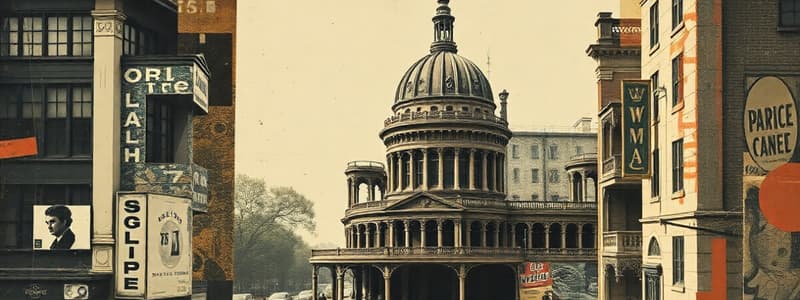Podcast
Questions and Answers
What is the definition of theory in architecture?
What is the definition of theory in architecture?
Abstract thought or speculation used to analyze, explain, or predict phenomena.
Which of the following are types of theory in architecture? (Select all that apply)
Which of the following are types of theory in architecture? (Select all that apply)
- Descriptive (correct)
- Critical
- Analytical
- Prescriptive (correct)
What are the main factors affecting architectural systems? (Select all that apply)
What are the main factors affecting architectural systems? (Select all that apply)
- Sensory characteristics (correct)
- Color and texture
- Socio-cultural factors (correct)
- User requirements (correct)
What does architecture embody according to the content?
What does architecture embody according to the content?
Architecture is only considered an art and does not involve science.
Architecture is only considered an art and does not involve science.
What is the purpose of structural systems in architecture?
What is the purpose of structural systems in architecture?
The ___________ system heightens the viewer’s perception of forms in space.
The ___________ system heightens the viewer’s perception of forms in space.
Match the following architectural concepts with their descriptions:
Match the following architectural concepts with their descriptions:
Flashcards are hidden until you start studying
Study Notes
Definition of Theory and Architecture
- Theory is an abstract thought or speculation used to analyze, explain, or predict phenomena.
- Theory is also used as a basis of action.
- There are two types of theory: descriptive and prescriptive.
- Descriptive theory explains an event or phenomena.
- Prescriptive theory prescribes guidelines.
- Architecture is the art and science of designing and constructing buildings.
- Art is the conscious use of skill, craft, and creative imagination in the production of what is beautiful, appealing, or of more than ordinary significance.
- Science is a branch of knowledge dealing with a body of facts or truths obtained by direct observation, experimental investigation, methodical study, and systematically arranged, showing the operation of general laws.
Architectural Systems and Orders
- Architectural systems are the architecture of space, structure, and enclosure.
- Architectural systems are achieved by means of technology and result in a system of assumptions or principles.
- The systems are achieved through the following:
- Structure and enclosure
- Environmental protection and comfort
- Health, safety, and welfare
- Durability.
- Architectural systems are composed of a program that accommodates user requirements, needs, and aspirations.
- The program takes into account socio-cultural factors, economic factors, legal restraints, and historical traditions and precedents.
- Architectural systems are compatible with their context, particularly the environment, site, and climate.
- The environment includes:
- Climate: sun, wind, temperature, and precipitation.
- Geography: soil, topography, vegetation, and water.
- Sensory and cultural characteristics of the place.
- The Villa Savoye, designed by Le Corbusier, is located in Paris.
- The Villa Savoye exemplifies the harmonious integration of interacting and interrelated parts of an architectural system.
- The Villa Savoye contains an organizational pattern, relationships, and hierarchy.
- The Villa Savoye also contains qualities of shape, color, texture, scale, and proportion.
- The Villa Savoye contains qualities of surface, edges, and openings.
Spatial System
- The spatial system encompasses the three-dimensional integration of program elements and spaces.
- The spatial system accommodates the multiple functions and relationships in a house.
Circulation System
- The Villa Savoye incorporates a circulation system, which is the stair and ramp connecting the three levels.
- The circulation system heightens the viewer's perception of forms in space and light.
Structural System
- The Villa Savoye features a structural system composed of a grid of columns supporting horizontal beams and slabs.
- The Villa Savoye utilizes cantilevers that acknowledge the direction of approach along the longitudinal axis.
Architectural Orders
- There are two categories of architectural orders:
- Physical:
- Solids and Voids
- Interior and Exterior
- Space
- Structure
- Enclosure
- Machine
- Perceptual: Sensory perception and recognition of the physical elements by experiencing them.
- Physical:
Studying That Suits You
Use AI to generate personalized quizzes and flashcards to suit your learning preferences.




